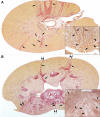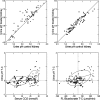Mechanism by which shock wave lithotripsy can promote formation of human calcium phosphate stones
- PMID: 25656372
- PMCID: PMC4398833
- DOI: 10.1152/ajprenal.00655.2014
Mechanism by which shock wave lithotripsy can promote formation of human calcium phosphate stones
Abstract
Human stone calcium phosphate (CaP) content correlates with higher urine CaP supersaturation (SS) and urine pH as well as with the number of shock wave lithotripsy (SWL) treatments. SWL does damage medullary collecting ducts and vasa recta, sites for urine pH regulation. We tested the hypothesis that SWL raises urine pH and therefore Cap SS, resulting in CaP nucleation and tubular plugging. The left kidney (T) of nine farm pigs was treated with SWL, and metabolic studies were performed using bilateral ureteral catheters for up to 70 days post-SWL. Some animals were given an NH4Cl load to sort out effects on urine pH of CD injury vs. increased HCO3 (-) delivery. Histopathological studies were performed at the end of the functional studies. The mean pH of the T kidneys exceeded that of the control (C) kidneys by 0.18 units in 14 experiments on 9 pigs. Increased HCO3 (-) delivery to CD is at least partly responsible for the pH difference because NH4Cl acidosis abolished it. The T kidneys excreted more Na, K, HCO3 (-), water, Ca, Mg, and Cl than C kidneys. A single nephron site that could produce losses of all of these is the thick ascending limb. Extensive injury was noted in medullary thick ascending limbs and collecting ducts. Linear bands showing nephron loss and fibrosis were found in the cortex and extended into the medulla. Thus SWL produces tubule cell injury easily observed histopathologically that leads to functional disturbances across a wide range of electrolyte metabolism including higher than control urine pH.
Keywords: histopathology; pH regulation; renal function; thick ascending limb.
Copyright © 2015 the American Physiological Society.
Figures







Similar articles
-
Potential role of fluctuations in the composition of renal tubular fluid through the nephron in the initiation of Randall's plugs and calcium oxalate crystalluria in a computer model of renal function.Urolithiasis. 2015 Jan;43 Suppl 1:93-107. doi: 10.1007/s00240-014-0737-1. Epub 2014 Nov 20. Urolithiasis. 2015. PMID: 25407799
-
Urine pH in renal calcium stone formers who do and do not increase stone phosphate content with time.Nephrol Dial Transplant. 2009 Jan;24(1):130-6. doi: 10.1093/ndt/gfn420. Epub 2008 Jul 28. Nephrol Dial Transplant. 2009. PMID: 18662977 Free PMC article.
-
Morphological changes induced in the pig kidney by extracorporeal shock wave lithotripsy: nephron injury.Anat Rec A Discov Mol Cell Evol Biol. 2003 Nov;275(1):979-89. doi: 10.1002/ar.a.10115. Anat Rec A Discov Mol Cell Evol Biol. 2003. PMID: 14533172
-
Brushite stone disease as a consequence of lithotripsy?Urol Res. 2010 Aug;38(4):293-9. doi: 10.1007/s00240-010-0289-y. Epub 2010 Jul 10. Urol Res. 2010. PMID: 20623223 Free PMC article. Review.
-
Pathophysiology-based treatment of idiopathic calcium kidney stones.Clin J Am Soc Nephrol. 2011 Aug;6(8):2083-92. doi: 10.2215/CJN.11321210. Clin J Am Soc Nephrol. 2011. PMID: 21825103 Free PMC article. Review.
Cited by
-
Discrepancy Between Stone and Tissue Mineral Type in Patients with Idiopathic Uric Acid Stones.J Endourol. 2020 Mar;34(3):385-393. doi: 10.1089/end.2019.0564. Epub 2020 Feb 3. J Endourol. 2020. PMID: 31880949 Free PMC article.
-
In Vivo Renal Tubule pH in Stone-Forming Human Kidneys.J Endourol. 2020 Feb;34(2):203-208. doi: 10.1089/end.2019.0378. J Endourol. 2020. PMID: 31760802 Free PMC article.
-
Arguments for choosing extracorporeal shockwave lithotripsy for removal of urinary tract stones.Urolithiasis. 2015 Oct;43(5):387-96. doi: 10.1007/s00240-015-0818-9. Epub 2015 Aug 28. Urolithiasis. 2015. PMID: 26315364 Review.
-
Metabolic diagnosis and medical prevention of calcium nephrolithiasis and its systemic manifestations: a consensus statement.J Nephrol. 2016 Dec;29(6):715-734. doi: 10.1007/s40620-016-0329-y. Epub 2016 Jul 25. J Nephrol. 2016. PMID: 27456839 Free PMC article.
-
Intraluminal measurement of papillary duct urine pH, in vivo: a pilot study in the swine kidney.Urolithiasis. 2016 Jun;44(3):211-7. doi: 10.1007/s00240-015-0834-9. Epub 2015 Nov 2. Urolithiasis. 2016. PMID: 26526044 Free PMC article.
References
-
- Capasso G, Unwin R, Rizzo M, Pica A, Giebisch G. Bicarbonate transport along the loop of Henle: molecular mechanisms and regulation. J Nephrol 15, Suppl 5: S88–S96, 2002. - PubMed
-
- Daudon M, Donsimoni RHC, Fellahi S, Le Moel G, Paris M, Troupel S, Lacour B. Sex and age-related composition of 10617 calculi analyzed by infrared spectropscopy. Urol Res 23: 326, 1995. - PubMed
-
- Drach GW, Dretler S, Fair W, Finlayson B, Gillenwater J, Griffith D, Lingeman J, Newman D. Report of the United States cooperative study of extracorporeal shock wave lithotripsy. J Urol 135: 1127–1133, 1986. - PubMed
Publication types
MeSH terms
Substances
Grants and funding
LinkOut - more resources
Full Text Sources
Other Literature Sources
Medical
Miscellaneous

